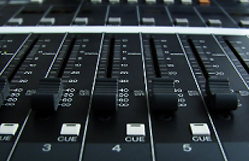A very simple and easy way to make your mixing life easier is using an optimal channel assignment strategy.
.
I’ve been doing this for so long that it wasn’t until this weekend, when someone else set up the mixer channels that I remembered the big difference it makes.
.
A simple manner of stage setup is placing the band on stage in the order they like and then plugging them into the closest stage boxes.
.
Then, you label the channels on the board.
.
Looking at your channel assignments, it might look like this:
Drums | Lead vocal | Guitar 1 | Vocal 2 | Bass | Vocal 3 | Guitar 2
Not too bad, right? Seven channels. They could be spread out if you have any unused channels in between.
Then this happens…
You set your gain structure and start EQ’ing. Now and then, you are tweaking the faders.
Eventually, you are working out the settings of two different guitars. They are four channels apart so you are constantly moving your eyes all over the board until finally… you tweak the Vocal 2 mid-range EQ and not the Guitar 1 mid-range EQ. Oops.
Optimize It
You can decrease those mistakes and increase the speed of your mixing when you use an optimal channel assignment. Imagine your channels laid out like this;
Drums | Guitar 1 | Guitar 2 | Bass | Vocal 1 | Vocal 2
Instruments are all together as are vocals. Even more important, guitars are together as are the vocals. Also, no unused channels are located in-between them.
What about the stage arrangement?
Channel assignments can be as easy as pressing buttons if you are in the digital world. Many digital mixers let you change the channel assignments.
What about the analog world?
There are a few options:
—Arrange the band members near the right stage boxes to meet your need. Personally, I don’t recommend this and only list it in case you consider it. Don’t. The band likes how they are set up and they are that way for a reason. Even with monitors, they still want to be next to the sounds they want to hear.
—Develop a stage schematic so you know where similars should be wired. Then, use enough cabling to get the job done. Make sure to tape it down with gaffer tape and preferably out of foot traffic areas on stage.
—Swap your mixer inputs. I only recommend doing this if you are comfortable with it and all your mixer inputs are labeled. Just be sure to patch them back to the original channels when you are done.
Summary
Limiting the range of eye movement over the mixer, you’ll decrease the time it takes to spot the right knob. It will also decrease the amount of mistakes you make because you grabbed the wrong one.
If you’ve never tried laying out your channels like this, try it for the next four times you are mixing. After that, you’ll never want it any other way.
Ready to learn and laugh? Chris Huff writes about the world of church audio at Behind The Mixer. He covers everything from audio fundamentals to dealing with musicians. He can even tell you the signs the sound guy is having a mental breakdown.





















